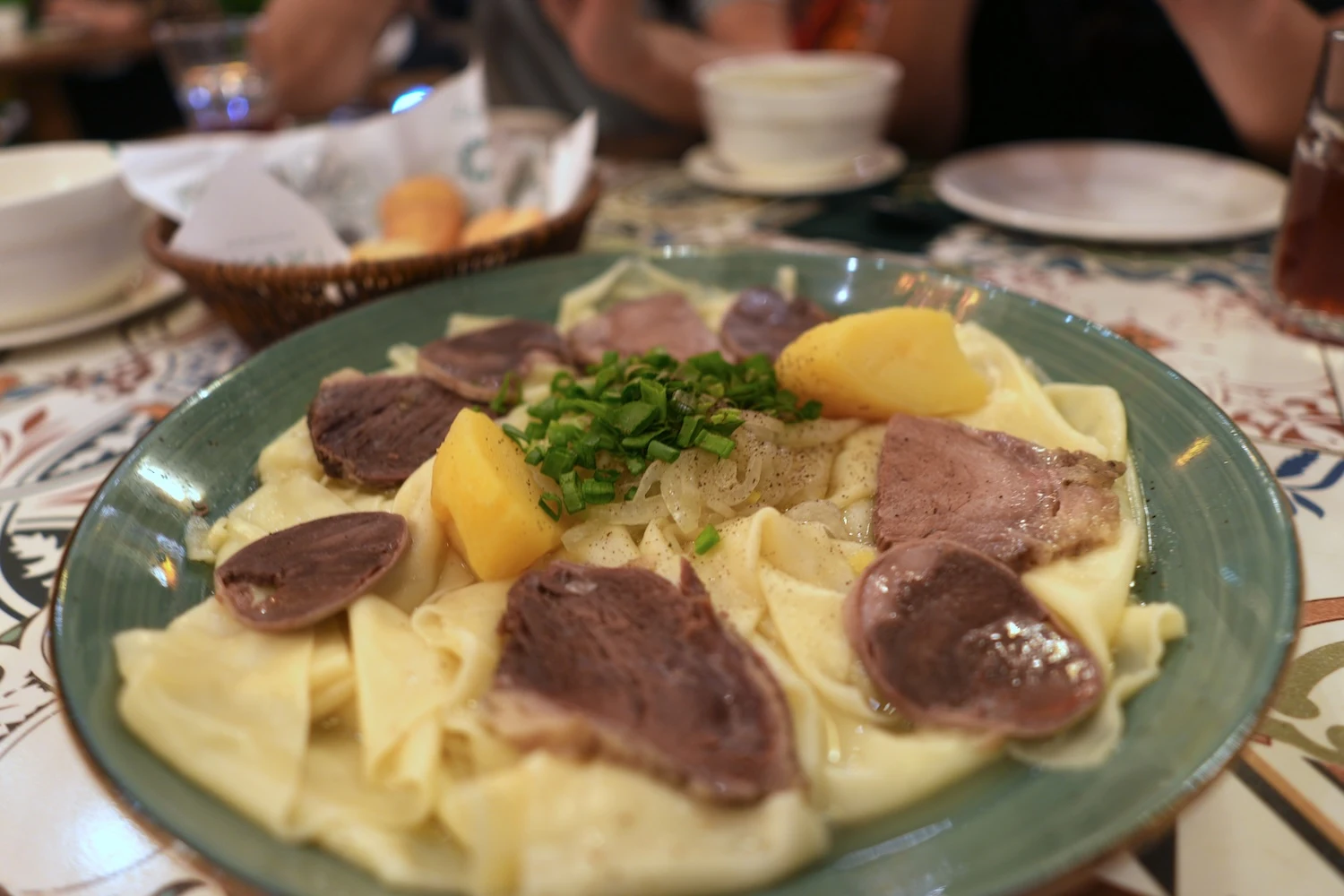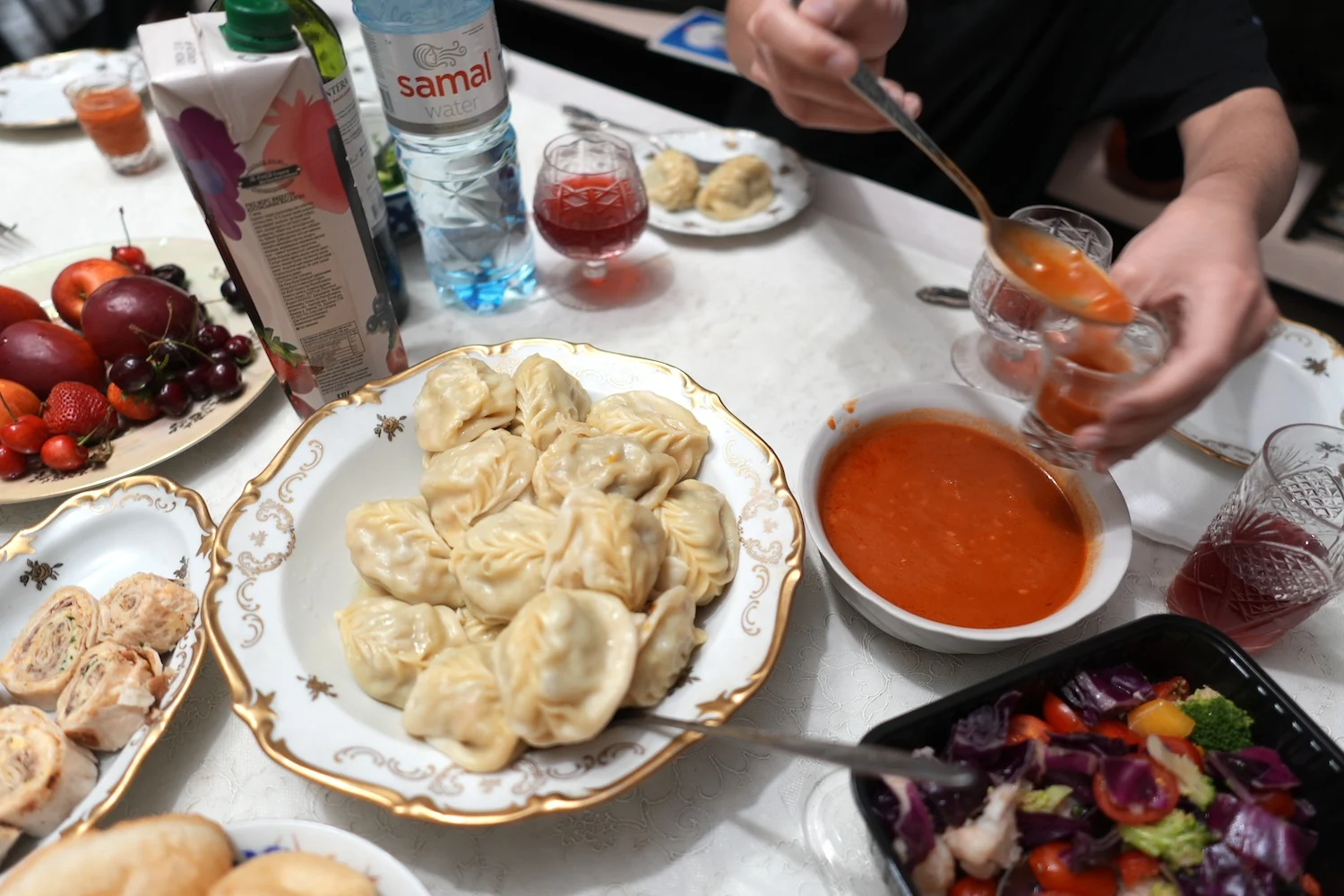Table of Contents
A Taste of Tradition: Exploring Kazakh Cuisine
Kazakhstan, known for its expansive steppes and rich nomadic heritage, offers a culinary journey that reflects its unique history and culture.
My deep connection to Kazakhstan comes from childhood summers spent with family in Almaty, where I developed a firsthand appreciation for its traditional foods. If you’re planning a trip to Kazakhstan, check out my blog for a perfect one-week itinerary.
In this blog post, I’ll share some of the most iconic dishes of Kazakh cuisine to help you discover the best food in Kazakhstan.
What is Traditional Kazakh Food?
Traditional Kazakh food is inherently nomadic, designed for a lifestyle that required portability, durability, and food on the go.
Historically, Kazakhs were herders who raised horses, sheep, cows, and camels, relying on these animals for transportation, clothing, and food. This way of life led to the development of cooking techniques that focused on preserving meat and milk products, ensuring they could last through long journeys.
Additionally, Kazakh cuisine has been heavily influenced by the culinary traditions of neighboring countries, including Russia, Uzbekistan, Kyrgyzstan, and China. I noticed this is strongly reflected in the spices used within the food.
Best Food in Kazakhstan You Must Try
What is Beshbarmak made of?
Beshbarmak: Beshbarmak is Kazakhstan’s national dish, which means “five fingers” because people eat it with their hands. It’s made of boiled meat, usually horse or lamb, served over flat noodles with an onion sauce.

What is Baursak made of?
Baursak: Baursak are fluffy, fried dough balls, kind of like donuts. They are usually eaten during special occasions, often with tea and a drizzle of honey or sugar.
What is Kazy made of?
Kazy: Kazy is a special sausage made from horse meat. It’s seasoned, put into horse intestines, and then smoked or dried. It’s often eaten during celebrations and can be enjoyed alone or with beshbarmak.

What is Kumis made of?
Kumis: Kumis is a drink made from fermented mare’s milk. It’s a bit fizzy and has been a part of Kazakh culture for a very long time.
What is Kurt made of?
Kurt: Kurt is a very salty cheese ball made from sour milk. It’s a great snack for long trips and can be added to soups or stews. You can also dissolve it in water to make a drink called shalap.

What is Shubat made of?
Shubat: Shubat is a drink made from fermented camel milk. It’s popular in summer and is known for being good for your digestion and skin.
What is Lagman made of?
Lagman: Lagman is a noodle dish with hand-pulled noodles, meat, and vegetables. It can be served as a soup or stir-fry and shows the influence of Chinese cooking.

What is Plov made of?
Plov: Plov is a rice dish cooked with meat, carrots, and onions. It’s a dish made for big gatherings, highlighting how important community is in Kazakh culture, and it’s inspired by Uzbek cuisine.
What are Manti made of?
Manti: Manti are steamed dumplings filled with lamb or beef and onions. Influenced by Central Asian and Turkish traditions, this Kazakh dish embodies family and community values through its communal preparation and sharing.

What is Shashlik made of?
Shashlik is made by grilling pieces of meat on skewers. Traditionally, it uses lamb or goat, but you can also find it made with pork, chicken, or beef. The meat is marinated in a mix with yogurt or vinegar, which makes it soft and flavorful.
The Influence of Nomadic Life on Kazakh Cuisine
Kazakhstan’s terrain and climate have shaped its culinary traditions. The need for food that could endure long periods without spoiling led to methods like drying and salting meat and fermenting milk. These practices ensured that Kazakh nomads had reliable sources of nutrition during their migrations.
For example, dishes like kurt and shubat are products of this necessity. Kurt’s high salt content and compact form made it easy to transport and store, while shubat’s fermentation process preserved the milk’s nutrients and made it safe to consume over time.
Conclusion
Kazakh cuisine is a testament to the country’s rich history and resilient spirit.
From the practical yet delicious nomadic foods to the communal dishes that bring people together, Kazakhstan’s culinary traditions offer a unique glimpse into its culture. The influence of neighboring countries, such as Russia, Uzbekistan, Kyrgyzstan, and China, has further enriched Kazakh cuisine, adding layers of flavor and diversity to its dishes.
As you explore these flavors, you’ll gain a deeper understanding of the nomadic lifestyle and the importance of community in Kazakh society.


4 comments
Shashlik is one of my all-time favorite foods! After my trip to Kazakhstan a few years back I started making my own at home using my charcoal grill. It is a staple in our summer BBQs now 🙂
Woah, that’s awesome! Shashlik is perfect for a summer barbeque:)
The Manti look scrumptious! I shouldn’t have read this post so far from dinner time!
Hahaha my grandma would be proud to hear that!